Coffea canephora
Coffea canephora (syn. Coffea robusta), commonly known as robusta coffee, is a species of coffee that has its origins in central and western sub-Saharan Africa. It is a species of flowering plant in the family Rubiaceae. Though widely known as Coffea robusta, the plant is scientifically identified as Coffea canephora, which has two main varieties, robusta and nganda.[1]
| Robusta coffee | |
|---|---|
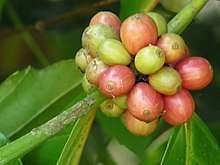 | |
| Berries of Coffea canephora | |
| Scientific classification | |
| Kingdom: | Plantae |
| Clade: | Tracheophytes |
| Clade: | Angiosperms |
| Clade: | Eudicots |
| Clade: | Asterids |
| Order: | Gentianales |
| Family: | Rubiaceae |
| Genus: | Coffea |
| Species: | C. canephora |
| Binomial name | |
| Coffea canephora Pierre ex A.Froehner | |
| Synonyms | |
|
Coffea robusta L.Linden | |
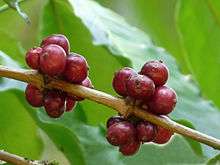
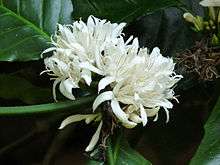
Description
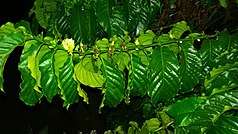
Robusta is a species of flowering plant in the family Rubiaceae. Though widely known by the synonym Coffea robusta, the plant is currently scientifically identified as Coffea canephora, which has two main varieties, C. c. robusta and C. c. nganda.[1] The plant has a shallow root system and grows as a robust tree or shrub to about 10 m tall. It flowers irregularly, taking about 10–11 months for cherries to ripen, producing oval-shaped beans.
The robusta plant has a greater crop yield than that of arabica, contains more caffeine (2.7% compared to arabica's 1.5%),[2] and contains less sugar (3–7% compared to arabica's 6–9%).[3] As it is less susceptible to pests and disease,[4] robusta needs much less herbicide and pesticide than arabica.
Native distribution
Originating in upland forests in Ethiopia, C. canephora grows indigenously in Western and Central Africa from Liberia to Tanzania and south to Angola. It was not recognized as a species of Coffea until 1897,[5] over a hundred years after Coffea arabica.[6][2] It is also reportedly naturalized in Borneo, French Polynesia, Costa Rica, Nicaragua, Jamaica and the Lesser Antilles.[7] In 1927 a hybrid between robusta and arabica was found in Timor. This strain was subsequently used to breed rust-resistant plants.[8]
Cultivation and use
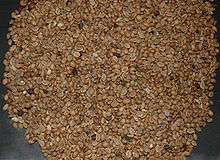
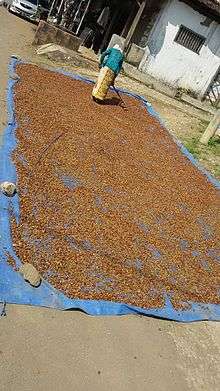
Robusta coffee is coffee made from beans of the plant Coffea canephora, a sturdy species with low acidity and high bitterness. C. canephora beans, widely known by the synonym Coffea robusta, are used primarily in instant coffee, espresso, and as a filler in ground coffee blends.
Robusta has its origins in central and western sub-Saharan Africa.[1] It is easy to care for, has a greater crop yield, has almost double the amount of caffeine and more antioxidants,[9] and is less susceptible to disease than arabica coffea.[8] It represents 43% of global coffee production, with arabica constituting the remainder except for the 1% constituted by coffea liberica[10]
It is mostly grown in Vietnam, where French colonists introduced it in the late 19th century, though it is also grown in India, Africa and Brazil, where it is often called conilon.[11] In recent years, Vietnam, which produces mostly robusta, has become the world's largest exporter of robusta coffee, accounting for over 40% of the total production.[10] It surpasses Brazil (25% of the world's production), Indonesia (13%), India (5%), and Uganda (5%).[10] Brazil is still the biggest coffee producer in the world, producing one-third of the world's coffee, though 69% of that is C. arabica.[10]
Robusta is easier to care for and has a greater crop yield than C. arabica, so is cheaper to produce.[12] Roasted robusta beans produce a strong, full-bodied coffee with a distinctive earthy flavour, but usually with more bitterness than arabica due to its pyrazine content.[13][14] Since arabica beans are believed to have smoother taste with more acidity and a richer flavour, they are often considered superior, while the harsher robusta beans are mostly used as a filler in lower-grade coffee blends.[12] However, the powerful flavour can be desirable in a blend to give it perceived "strength" and "finish", noticeably in Italian coffee culture. Good-quality robusta beans are used in traditional Italian espresso blends, at about 10–15%, to provide a full-bodied taste and a better foam head (known as crema). It is besides used as a stimulant, diuretic, antioxidant, antipyretic and relieves spasmodic asthma.[15][16]
See also
References
- J. Dagoon (2005). Agriculture & Fishery Technology Iv. Rex Bookstore, Inc. p. 58. ISBN 9789712342233. Retrieved 22 July 2011.
- Mark Nesbitt (2005). The Cultural History of Plants. Taylor & Francis. pp. 176–177. ISBN 978-0-203-02090-6. Retrieved 22 July 2011.
- "Understanding the Difference: Arabica vs Robusta". The Coffee Barrister. 31 July 2016. Retrieved 2 August 2016.
- Benoit Daviron; Stefano Ponte (2005). The Coffee Paradox: Global Markets, Commodity Trade and the Elusive Promise of Development. Zed Books. p. 51. ISBN 978-1-84277-457-1.
- Adolf, Engler; Germany), Königlicher Botanischer Garten (Berlin; Germany), Königliches Botanisches Museum (Berlin (1895–1918). "Notizblatt des Königl. Botanischen Gartens und Museums zu Berlin". bd.1 (1895–1897). In Commission bei Wilhelm Engelmann. Cite journal requires
|journal=(help) - von, Linné, Carl; Lars, Salvius (1753). "Caroli Linnaei ... Species plantarum". 1. Impensis Laurentii Salvii. Cite journal requires
|journal=(help) - "World Checklist of Selected Plant Families: Royal Botanic Gardens, Kew". apps.kew.org. Retrieved 1 August 2017.
- Penarredonda, Jose Luis (6 November 2017). "The disease that could change how we drink coffee". BBC: In depth, Food. Retrieved 23 November 2017.
- Vignoli, J. A.; Bassoli, D. G.; Benassi, M. T. (2011). "Antioxidant activity, polyphenols, caffeine and melanoidins in soluble coffee: The influence of processing conditions and raw material". Food Chemistry. 124 (3): 863–868. doi:10.1016/j.foodchem.2010.07.008.
- "Coffee: World Markets and Trade" (PDF). United States Department of Agriculture – Foreign Agricultural Service. December 2019. Retrieved 8 May 2020.
- A. Rami Horowitz (2004). Insect pest management: field and protected crops. Springer. p. 41. ISBN 978-3-540-20755-9. Retrieved 23 August 2011.
- Miyanari, Walter (2008). Aloha Coffee Island. Savant Books & Publications. p. 7. ISBN 978-0-615-18348-0. Retrieved 13 December 2011.
- Andrew J. Taylor, Robert Linforth (2010). Food Flavour Technology. John Wiley and Sons. p. 68. ISBN 978-1-4443-1778-7. Retrieved 13 December 2011.
- Wintgens, Jean Nicolas (2009). Coffee: Growing, Processing, Sustainable Production: A Guidebook for Growers. Wiley-VCH. p. 799. ISBN 978-3-527-32286-2. Retrieved 13 December 2011.
- Reynolds, Richard (1 February 2006). "Robusta's Rehab". CoffeeGeek. Coffee Geek. Retrieved 5 January 2010.
- Robertson, Carol (2010). The Little Book of Coffee Law. American Bar Association. p. 52. ISBN 978-1-60442-985-5. Retrieved 13 December 2011.
External links
| Wikimedia Commons has media related to Coffea canephora. |
| Wikispecies has information related to Coffea canephora |
